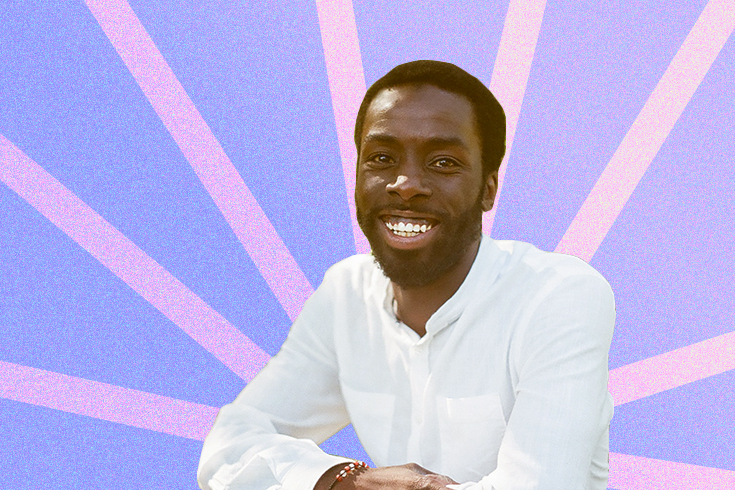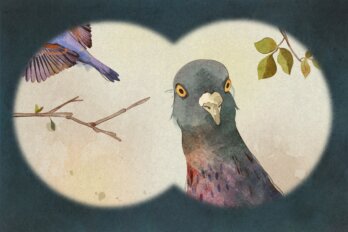Desmond Cole’s “The Skin I’m In,” a 2015 Toronto Life cover story, was an impressive piece of journalism. It looked at the rise of carding—the police practice of stopping people on the street, demanding identification, and recording details like height, weight, race, and eye colour—and how that tactic was disproportionately used to target and track young black men in Toronto. Cole’s moving article delivered a clear call to action: carding was racist and needed to be stopped. But it was more than just a powerful story. For some people, myself included, it was the first time we saw our lived experience represented in Canadian media. Since then, Cole has continued to challenge the biases and blind spots in media and politics, even if it means staging a sit-in and being removed by law enforcement.
In January, Cole published his first book, The Skin We’re In. While his 2015 article is a personal essay, his book spans an entire year, illustrating the realities and injustices of Black Canadian life under white supremacy. The book is a work of heavy reporting, covering such events as the police attack against Dafonte Miller and the history of Black immigration. These scenes are complemented by Cole’s personal experiences, episodes in which we see Desmond out in the world and free—not as a journalist, not as an activist, but as a person.
I sat down with Desmond Cole at the Penguin Random House office in Toronto, where we talked about anti-Blackness, white supremacy, and what it means to be free.
This interview has been edited for length and clarity.
Téa Mutonji: I was a media student in 2017, the year when most of the events in your book took place. With the exception of the story of Dafonte Miller—who was punched and beaten with a metal pipe by off-duty Toronto police officer Michael Theriault and his brother, Christian Theriault, in 2016—your book was the first time I was exposed to these events. Apparently they were covered by the very news outlets I was studying, but I never saw them. That was part of my shock while reading—how these stories hadn’t reached me.
Desmond Cole: Thank you for saying that. I’ve been fighting for what feels like this entire decade to see these stories represented in the mainstream. It’s a difficult battle because I think that our media industry in Canada, which is so very white, is resistant to giving these stories the platform that they deserve. I don’t mean to sound contradictory, because if you look at the sourcing that I used in my book, it’s not like it’s all from independent, unknown media outlets. I use mainstream sources—the big legacy newspapers, the three or four major television networks that we have in this country. I can’t say they’re completely ignoring these stories, because there is coverage. But what’s missing is any attempt to connect these stories to a bigger reality.
TM: What are the consequences of this sort of erasure in mainstream media?
DC: When anti-Blackness surfaces in our media, it’s almost always framed as a surprise. No matter how many times it happens, white people consistently feign surprise, especially in Canada, because we construct our national identity with this idea that it could never be us, that it belongs to the people in the country south of us.
What’s missing from this story—and I mentioned this example in the book—is in the coverage of Daniel Montsion, who got out of his police car and attacked Abdirahman Abdi in Ottawa. I have been following that trial for nearly four years. CBC Ottawa has provided spectacular coverage. The Ottawa Citizen has provided some very good coverage too, but both of those are local news publications that are a part of national media organizations. You don’t see those larger corporate entities taking up this story on a national level and saying, “This is what it means to be Black in Canada. This is how anti-Blackness manifests in Canadian policing.” It’s treated as a one-off. And what that type of coverage does is it keeps white supremacy safe by saying, “Well, you know, mistakes happen. There are bad apples. Don’t worry about it—it’s not as though this is a pattern.” But, of course, it is. That’s the whole problem with it—as a system, it’s designed to reproduce all of this violence against Black people, but our media doesn’t want to connect those dots.
TM: This problem has, essentially, become the backbone of your work.
DC: That’s why I keep getting into trouble in the Canadian media industry—because I refuse to pretend to suspend my judgment about white supremacy in this country. If you have made up your mind about white supremacy in this country, you are considered biased. We have this fiction of objective journalism that no one can define or explain to me, and I’m supposed to be adhering to it. But I’ve never met an objective person in my life. I can’t point to an objective news agency in Canada, and that’s not an insult. Not only does objectivity not exist, it wouldn’t be desirable even if it did exist. I don’t want people to hear about a six-year-old being handcuffed inside of her school and to look at that objectively, to suppress whatever emotion they immediately feel upon hearing that story and put it to the side as if doing so is in the public interest. If you get angry hearing that a six-year-old forty-eight pound Black girl is being chained by her wrists and ankles at school, then you should convey that anger in your reporting. That’s the human thing to do. To suppress that anger in the name of so-called objectivity is just to normalize the violence. And I refuse to do that.
TM: I want to come back to people’s opinions on and reactions to your work. In live interviews, oftentimes when you are being questioned, the questioner comes off quite aggressively. Sometimes it feels like they’re not really engaging in conversation with you but actually attacking you. I remember reading the term “race-baiting,” including in Rebel News, in responses to your work. How do you grapple with comments like that?
DC: One of the main reasons this media culture gives Black people a platform is to try to discredit us. We fight and we fight and we fight and we fight to get our stories heard, and then finally someone says, “I’m interested in talking to you,” but their obsession becomes, “Shouldn’t you do it this way instead? Aren’t you too angry? Do you really think that the white Canadian public is gonna go in for this?” What they don’t understand is that I don’t care. The truth is the truth, and I am not here to seduce white Canada with a story that it can handle about what it means to be Black or what the state of racism is. I’m just here to tell the truth.
TM: Where does the oversight happen? What are we seeing that the rest of Canada seems to overlook?
DM: Canada is not just some player in the corner of the world, in the shadow of the United States, watching what happens in the world and reacting to it. We’re exporting white supremacy ourselves; we’re creating systems of white supremacy and then showing other white-dominated countries, “Here’s how you subjugate people.” All of these phenomena are international. I think that’s the problem, and that’s why I quoted Michelle Hopkins, in the first chapter of my book, saying: “Black lives have no borders.”
TM: Your book touches a lot on how white supremacy is affecting young people. Early on in the book, we see the story of a six-year-old getting handcuffed, and we end it with young people showing up to protest for a young Black man named Abdoul Abdi.
DC: I think the thing that media and politicians and corporations direct us to be most afraid of is a Black cis man and his dangerous body that always needs to be controlled. But, in the book, there is also this six-year-old girl who was handcuffed inside of her school in Mississauga and had been suspended at least four times by then. When we pull back and look at the statistics, this girl’s experience is not a shock or a surprise. Black students in Toronto public schools are about three times more likely to be suspended than white students are. The system is designed so that Black children aren’t allowed to be seen as children. That’s a constant, and that’s how it starts. It’s the same with Dafonte Miller. He was nineteen years old and suffered a life-altering injury to his eye. When this level of violence is taking place in our schools and on our streets, it instills this fear that tries to control young Black people: “Don’t you dare step out of line. You know we’ve got punishment on deck for you if you ever think that you will be free in this society.”
TM: And, when it comes to Black women, not only are we targets for the world, but we’re also targeted by Black men and by one another.
DC: I think that the patriarchy is one of the only ways that this white supremacist system allows Black men to feel power. We should talk about the violence that Black men are doing to Black women. We should talk about those internal ways in which patriarchy is manifesting itself in our own community. To the extent that Black men are allowed to be leaders in business, in politics, in art—Where are all the Black women? The industry is not acknowledging their work in the same way. It might be uncomfortable for Black men, but patriarchy gives us that edge and we need to acknowledge that.
TM: Do you talk to the kids you work with about that? Those behaviours, they have to start somewhere.
DC: In 2018, I did this whole session with young Black kids in the Ontario child welfare system. And you start talking to young Black people about some of their experiences in the child welfare system, or at school, and girls were talking about things like traditional dress codes in schools and the specific ways that they targeted Black girls. Now, if you’re Black boy who likes to wear a baseball cap or a durag, there’s absolutely going to be discrimination for you, but it’s different from a Black girl who’s going to be told about the straps that she’s wearing, that she shouldn’t show too much skin, or that her hair is too big when she sits in class. These things are not the same. But we do have to have these conversations to teach Black students it’s not a competition. We’re in solidarity. We’re listening to the experiences that are not our own. We’re listening to Black queer and trans students who are like, “Hey, I’m basically invisible in this school system.” This is the thing that Black Lives Matter Toronto has done so effectively in this city: to bring Black queer and trans organizing to the forefront of the Black struggle. We don’t want our young people to think that we have to fight one another in order to be heard.
TM: You don’t talk much about your personal life in all of this. Instead, you give us a chapter called “Deep Breath.”
DC: I needed to do that.
TM: It comes at a time in the book when I felt like I couldn’t handle any more of these stories. It was almost like a reward for committing to the brutal opening chapters. This chapter provides a rare glimpse into your personal life. We really get to see you in your own world and get to appreciate your love for flowers and nature. This is Desmond without the activism, without the journalism, just Desmond out on the street.
DC: I needed to write that chapter because it was so hard to write the first four. These are the realities of a journalist—you want to be thorough. You want to have as much information as is available to you when you’re creating your story. But listening to 911 calls where we hear the voice of [Abdirahman Abdi] during his last moments on this planet and watching interviews and reading articles about relatives and neighbours and friends who witnessed those moments—that was terrible. I didn’t want to have to do that work, but it was necessary in order to write a proper account. The “Deep Breath” chapter reflects my personal need to seek out beauty: the need to be playful and to relax and to take solace in my friends and my family. These stories and this reality can be overwhelming, but this part is also our life.
TM: What’s this book meant to do in this world?
DC: First and foremost, it is meant to allow us, as Black people, to see ourselves reflected in journalism: a journalism that is Black centred, that is honest about what we are experiencing, and that doesn’t play this game of objectivity with our lives. But, beyond that, it’s for anyone invested in a liberation that acknowledges white supremacy and anti-Blackness, or who just doesn’t understand why there would be a Black Lives Matter movement in Canada. Not from a place of deep skepticism or anger or defensiveness but true openness and wanting to learn. It’s for people who see these movements emerging in Canada and have genuine curiosity about them. Especially young people who are hungry with curiosity, who haven’t yet become incredibly jaded by the world around them.
TM: I don’t think I’ll ever date another white person if they don’t first agree to read this book in full and write me a small synopsis per chapter. I’ll leave with one question: Now that we’re in 2020, are we still talking about what’s been done to us? Or are we now trying to imagine a utopia that’s closer to a postracial world?
DC: We are always building on our history. We are nothing if we don’t understand how we got here. There’s no separating what has happened from what is happening from what’s going to happen. And I don’t believe in a postracial world. I’m Black now and I’m always going to be Black. I want to be allowed to be Black and live, thrive, prosper. The world, that utopia that you mention, allows me to both be Black and to live freely. I don’t want Black erasure for the sake of liberation. I truly want liberation itself, as a Black person.





